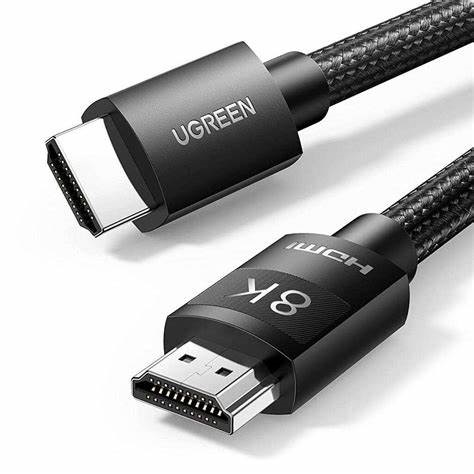Are you wondering if you need to upgrade to an HDMI 2.1 cable for your device? HDMI 2.1 is the latest version of the HDMI standard, offering higher bandwidth and new features such as support for 8K resolution and variable refresh rate. While HDMI 2.1 cables are backward compatible with older HDMI devices, not all devices will benefit from the new features. In this article, we will explore the need for HDMI 2.1 cables and the benefits they offer.

Understanding HDMI 2.1 is crucial to determining whether you need a new cable. HDMI 2.1 offers a higher bandwidth of up to 48 Gbps, compared to 18 Gbps for HDMI 2.0. This increased bandwidth enables higher resolutions, higher frame rates, and new features such as dynamic HDR and eARC. However, not all devices support these new features, and some may require additional hardware upgrades to take full advantage of HDMI 2.1. In the following sections, we will explore the benefits of HDMI 2.1 cables and the devices that can benefit from them.
Key Takeaways
- HDMI 2.1 offers higher bandwidth and new features such as support for 8K resolution and variable refresh rate.
- Not all devices will benefit from the new features of HDMI 2.1, and some may require additional hardware upgrades.
- Devices such as gaming consoles and high-end TVs are more likely to benefit from HDMI 2.1 cables.
Understanding HDMI 2.1
HDMI 2.1 is the latest version of the HDMI (High-Definition Multimedia Interface) specification, developed by the HDMI Forum. It was first introduced in 2017 and has since become the standard for connecting audio and video devices, such as TVs, gaming consoles, and soundbars. HDMI 2.1 offers several improvements over its predecessor, HDMI 2.0, including increased bandwidth, higher resolutions, and faster refresh rates.
One of the most significant improvements of HDMI 2.1 is its increased bandwidth, which allows for higher resolutions and faster refresh rates. HDMI 2.1 can support resolutions up to 10K at 120 frames per second (fps), as well as 8K at 60 fps and 4K at 120 fps. These higher resolutions and faster refresh rates are especially beneficial for gamers and those who enjoy watching sports or action movies.
HDMI 2.1 also includes support for dynamic HDR (High Dynamic Range), which allows for better color depth and contrast. It also supports eARC (Enhanced Audio Return Channel), which allows for high-quality audio to be transmitted from the TV to a soundbar or home theater system.
If you’re wondering whether you need to upgrade to an HDMI 2.1 cable, the answer is that it depends on your specific devices and needs. If you have a device that supports HDMI 2.1, such as a new gaming console or TV, then you will need an HDMI 2.1 cable to take advantage of its features. However, if your devices only support HDMI 2.0 or earlier versions, then an HDMI 2.1 cable may not make a significant difference.
In summary, HDMI 2.1 is the latest version of the HDMI specification, offering several improvements over its predecessor, including increased bandwidth, higher resolutions, and faster refresh rates. Whether you need an HDMI 2.1 cable depends on your specific devices and needs.
The Need for HDMI 2.1 Cables
If you’re wondering whether you need a new HDMI 2.1 cable for your device, the answer is: it depends. HDMI 2.1 is a new standard that supports higher resolutions, refresh rates, and other features that are not available on previous versions of HDMI.
Here are some situations where you might need an HDMI 2.1 cable:
- If you have a device that supports HDMI 2.1, such as a new gaming console or a high-end TV, and you want to take advantage of its features, you will need an HDMI 2.1 cable.
- If you have an older HDMI cable that is not labeled as “Ultra High Speed” or “Premium High Speed,” it may not be able to handle the bandwidth required for HDMI 2.1 features. In this case, you will need to upgrade to an HDMI 2.1 cable.
However, if you have a device that does not support HDMI 2.1 and you’re not planning to upgrade anytime soon, you don’t need an HDMI 2.1 cable.
It’s important to note that all HDMI 2.1 cables are labeled as “Ultra High Speed HDMI Cables.” If you see a cable labeled as “Ultra High Speed HDMI Cable,” it means it supports HDMI 2.1 features.
In summary, if you have a device that supports HDMI 2.1 and you want to take advantage of its features, you will need an HDMI 2.1 cable. If you have an older HDMI cable that is not labeled as “Ultra High Speed” or “Premium High Speed,” you may need to upgrade to an HDMI 2.1 cable.
Benefits of HDMI 2.1 Cables
If you’re wondering whether you need to upgrade your HDMI cable to HDMI 2.1, there are several benefits to consider. Here are some of the key advantages of using HDMI 2.1 cables:
High Speed and Bandwidth
HDMI 2.1 cables offer a significant increase in speed and bandwidth over previous HDMI versions. With a bandwidth throughput of up to 48Gbps, these cables can handle high-resolution content with ease. This means you can enjoy 4K and even 8K content at higher frame rates without any lag or stuttering.
Premium and Ultra High Speed
HDMI 2.1 cables are classified as either Premium or Ultra High Speed. Premium HDMI cables can support 4K content at 60Hz, while Ultra High Speed HDMI cables can handle 8K content at 60Hz. This means you can future-proof your home theater setup with HDMI 2.1 cables.
Improved Data Transmission
HDMI 2.1 cables also offer improved data transmission capabilities. They use a new technology called “pipes” to transmit data more efficiently, reducing the risk of signal loss or degradation. This means you can enjoy a more stable and reliable connection between your devices.
Overall, HDMI 2.1 cables offer a significant improvement over previous HDMI versions. If you’re looking to upgrade your home theater setup and enjoy the latest high-resolution content, investing in HDMI 2.1 cables is definitely worth considering.
HDMI 2.1 and Video Quality
If you’re wondering whether you need to upgrade to an HDMI 2.1 cable for better video quality, the answer is a bit complicated. HDMI 2.1 does support higher resolutions, such as 4K and 8K, as well as higher frame rates and High Dynamic Range (HDR) content. However, whether you’ll see a noticeable improvement in video quality depends on a few factors.
One of the biggest factors is the content you’re watching. If you’re watching 4K or 8K content, an HDMI 2.1 cable can help ensure that the signal is delivered without any loss of quality. Additionally, if you’re watching HDR content, an HDMI 2.1 cable can help ensure that the metadata for dynamic HDR is delivered correctly, resulting in brighter, more vivid images.
Another factor to consider is the device you’re using. While HDMI 2.1 is backward compatible, not all devices support all of the features of the new standard. For example, if you have a PlayStation 5 or Xbox Series X, you’ll need an HDMI 2.1 cable to take advantage of their 4K/120Hz capabilities. Similarly, if you have a high-end graphics card, you’ll need an HDMI 2.1 cable to take advantage of its 8K capabilities.
In summary, an HDMI 2.1 cable can help ensure that you’re getting the best possible video quality, especially if you’re watching 4K or 8K content or HDR content. However, whether you need to upgrade to an HDMI 2.1 cable depends on the content you’re watching and the devices you’re using.
HDMI 2.1 and Gaming
If you’re a gamer, then you’ll be happy to know that HDMI 2.1 cables can significantly enhance your gaming experience. HDMI 2.1 offers several features that can improve gaming performance, including higher frame rates, variable refresh rates (VRR), and quick frame transport (QFT).
With HDMI 2.1, you can achieve refresh rates of up to 120Hz, which means smoother gameplay with less motion blur. This is especially important for fast-paced games where every millisecond counts. Higher frame rates also mean a more immersive experience, as the game appears more fluid and lifelike.
VRR is another feature that can greatly enhance your gaming experience. It synchronizes the refresh rate of your TV with the frame rate of your game, which eliminates screen tearing and stuttering. This results in a smoother and more enjoyable gaming experience.
QFT is a feature that reduces latency, which is the delay between your controller input and the action on the screen. With QFT, you can enjoy a more responsive gaming experience, which is especially important for competitive gaming.
HDMI 2.1 also supports 4K at 120Hz, which means you can enjoy high-resolution gaming without sacrificing performance. This is great news for gamers who own the latest graphics cards from AMD and NVIDIA, which support 4K at 120Hz.
In summary, if you’re a gamer, then HDMI 2.1 is definitely worth considering. It offers several features that can greatly enhance your gaming experience, including higher frame rates, VRR, and QFT. With HDMI 2.1, you can enjoy smoother gameplay, reduced latency, and a more immersive experience.
HDMI 2.1 and Sound Quality
HDMI 2.1 cables are designed to support the latest audio and video formats, including Dolby Vision, Dolby Atmos, and DTS. With HDMI 2.1, you can enjoy high-quality sound that is immersive and engaging.
One of the key features of HDMI 2.1 is the Enhanced Audio Return Channel (eARC), which allows for higher-quality audio to be sent from your TV to your soundbar or AV receiver. eARC supports up to 32 channels of audio, including 3D audio formats like Dolby Atmos and DTS.
If you have a soundbar or AV receiver that supports eARC, then you should definitely consider upgrading to an HDMI 2.1 cable. This will allow you to take advantage of the higher-quality audio that eARC provides.
However, if your soundbar or AV receiver does not support eARC, then you may not see a significant improvement in sound quality by upgrading to an HDMI 2.1 cable. In this case, you may want to consider upgrading your sound system to one that supports eARC.
Overall, HDMI 2.1 cables are a great choice for anyone who wants to enjoy the latest audio and video formats. Whether you have a soundbar or AV receiver that supports eARC or not, upgrading to an HDMI 2.1 cable is a good investment that will future-proof your system and ensure that you can enjoy the best possible sound and picture quality.
Compatibility of HDMI 2.1 Cables
One of the great things about HDMI 2.1 is that it is backward compatible with older HDMI versions. This means that you can use your current HDMI cables and equipment with new HDMI 2.1 devices without any issues. However, you won’t be able to take advantage of the new features of HDMI 2.1 without upgrading your cables.
If you have an older HDMI cable, it will still work with HDMI 2.1 devices, but you won’t be able to take advantage of the higher bandwidth and other features that HDMI 2.1 offers. To get the full benefits of HDMI 2.1, you will need to upgrade to an HDMI 2.1 cable.
It’s also worth noting that some older devices may require a firmware upgrade to be compatible with HDMI 2.1. If you’re not sure whether your device needs a firmware update, check the manufacturer’s website or contact their customer support.
In summary, HDMI 2.1 is backward compatible with older HDMI versions, so you can use your current cables and equipment with new HDMI 2.1 devices. However, to get the full benefits of HDMI 2.1, you will need to upgrade to an HDMI 2.1 cable. Some older devices may also require a firmware upgrade to be compatible with HDMI 2.1.
HDMI 2.1 and TV Brands
If you’re in the market for a new TV, you might be wondering which brands support HDMI 2.1. The good news is that many of the major TV manufacturers are on board with this new standard, so you have plenty of options to choose from.
Samsung: Samsung has been a leader in the TV market for years, and their latest models are no exception. Many of their 4K and 8K TVs support HDMI 2.1, including their flagship QLED models.
Sony: Sony is another big player in the TV market, and they have a range of models that support HDMI 2.1. Their Bravia line of TVs is particularly popular, and many of these models support 4K and 8K resolutions.
LG: LG is known for producing high-quality OLED TVs, and many of their latest models support HDMI 2.1. Their OLED TVs are particularly impressive, with stunning picture quality and deep blacks.
Vizio: Vizio is a newer player in the TV market, but they have quickly gained a following thanks to their high-quality and affordable TVs. Many of their latest models support HDMI 2.1, including their flagship OLED TV.
TCL: TCL is another budget-friendly TV brand that has gained a lot of attention in recent years. Many of their latest models support HDMI 2.1, including their popular 6-Series and 8-Series models.
Overall, if you’re in the market for a new TV, it’s a good idea to look for models that support HDMI 2.1. This new standard offers a range of benefits, including faster refresh rates, higher resolutions, and improved gaming performance. Whether you’re looking for a high-end flagship TV or a budget-friendly option, there are plenty of brands and models to choose from.
HDMI 2.1 and Gaming Consoles
If you’re a gamer, you might be wondering if you need to upgrade to an HDMI 2.1 cable for your gaming console. The short answer is that it depends on your setup and what you’re looking to get out of your gaming experience.
The Xbox Series X and the PlayStation 5 both support HDMI 2.1, which means you can take advantage of the higher resolutions and frame rates that the cable can provide. However, not all games are currently compatible with HDMI 2.1, so you’ll want to do your research to see which games support it.
If you’re someone who wants the absolute best gaming experience possible, then upgrading to an HDMI 2.1 cable might be worth it. You’ll be able to take advantage of features like Variable Refresh Rate (VRR) and Auto Low Latency Mode (ALLM), which can help reduce input lag and screen tearing.
That being said, if you’re happy with your current gaming setup and don’t feel like you need to upgrade, then there’s no need to rush out and buy an HDMI 2.1 cable. You’ll still be able to play all of your favorite games on your current setup.
In summary, if you’re a hardcore gamer who wants the best possible gaming experience, then upgrading to an HDMI 2.1 cable might be worth it. However, if you’re happy with your current setup, then there’s no need to rush out and buy a new cable.
HDMI 2.1 and Other Devices
If you’re wondering whether you need an HDMI 2.1 cable for your device, it’s important to consider what other devices you have in your setup. HDMI 2.1 is backward compatible with HDMI 2.0 and earlier versions, so you can use an HDMI 2.1 cable with any device that has an HDMI port. However, you won’t be able to take advantage of the new features of HDMI 2.1 unless all of your devices support it.
Here’s a breakdown of some common devices and whether they support HDMI 2.1:
- Home entertainment systems: If you have a home theater system with multiple devices, such as a Blu-ray player, AV receiver, and projector, you’ll need to check each device to see if it supports HDMI 2.1. Some newer models may have HDMI 2.1 ports, while older models may only have HDMI 2.0 ports.
- Blu-ray players: Most Blu-ray players on the market today have HDMI 2.0 ports, but some newer models may have HDMI 2.1 ports. Check the specifications of your Blu-ray player to see if it supports HDMI 2.1.
- Displays: Many new displays, such as 4K and 8K TVs, have HDMI 2.1 ports. If you have an older display, it may only have HDMI 2.0 or earlier ports. Check the specifications of your display to see if it supports HDMI 2.1.
- DisplayPort: DisplayPort is a competing standard to HDMI, and it’s commonly used for computer monitors. DisplayPort 2.0 supports many of the same features as HDMI 2.1, such as 8K resolution and higher refresh rates. However, not all devices support DisplayPort 2.0, so you’ll need to check the specifications of your devices to see what they support.
- One Connect Box: Some Samsung TVs come with a One Connect Box, which is a separate box that houses all of the TV’s ports. The One Connect Box for some newer Samsung TVs has HDMI 2.1 ports, which can be used with compatible devices.
- ASUS: Some newer ASUS laptops and desktops have HDMI 2.1 ports. Check the specifications of your ASUS device to see if it supports HDMI 2.1.
It’s important to note that even if your devices don’t support HDMI 2.1, you can still use an HDMI 2.1 cable with them. The cable will work just like an HDMI 2.0 cable, but you won’t be able to take advantage of the new features of HDMI 2.1.
Additional Features of HDMI 2.1
HDMI 2.1 cables offer a range of additional features that can enhance your viewing experience. Here are some of the most notable features:
- Quick Media Switching (QMS): This feature allows for faster switching between different media types, such as from a movie to a video game, without any delay or black screen. QMS is especially useful for those who use their devices for multiple purposes.
- Auto Low Latency Mode (ALLM): This feature automatically switches your TV to its lowest latency mode when it detects that you are playing a game. This reduces lag and ensures a smoother gaming experience.
- Certification Program: HDMI 2.1 cables are certified to ensure that they meet the required standards for bandwidth, resolution, and other features. This certification ensures that you get the best possible performance from your HDMI 2.1 cable.
- 60Hz Refresh Rate: HDMI 2.1 cables support a 60Hz refresh rate, which means that you can enjoy smoother and more fluid motion on your screen.
- Length: HDMI 2.1 cables are available in a range of lengths, from 1 to 10 meters. This makes it easy to find a cable that is the right length for your needs.
Overall, HDMI 2.1 cables offer a range of additional features that can enhance your viewing and gaming experience. Whether you’re looking for faster switching between media types, reduced lag in games, or a smoother refresh rate, HDMI 2.1 cables are a great choice.
 World inside pictures Collect and share the best ideas that make our life easier
World inside pictures Collect and share the best ideas that make our life easier





